Inquiry into a Health System Failure
VerifiedAdded on 2023/06/08
|8
|1772
|444
AI Summary
This paper discusses the issues in Organizational Culture, Leadership and Management that were associated with the health system failure of Djerriwarrh Health Services, Bacchus Marsh, Victoria, Australia hence high perinatal mortality rates.
Contribute Materials
Your contribution can guide someone’s learning journey. Share your
documents today.
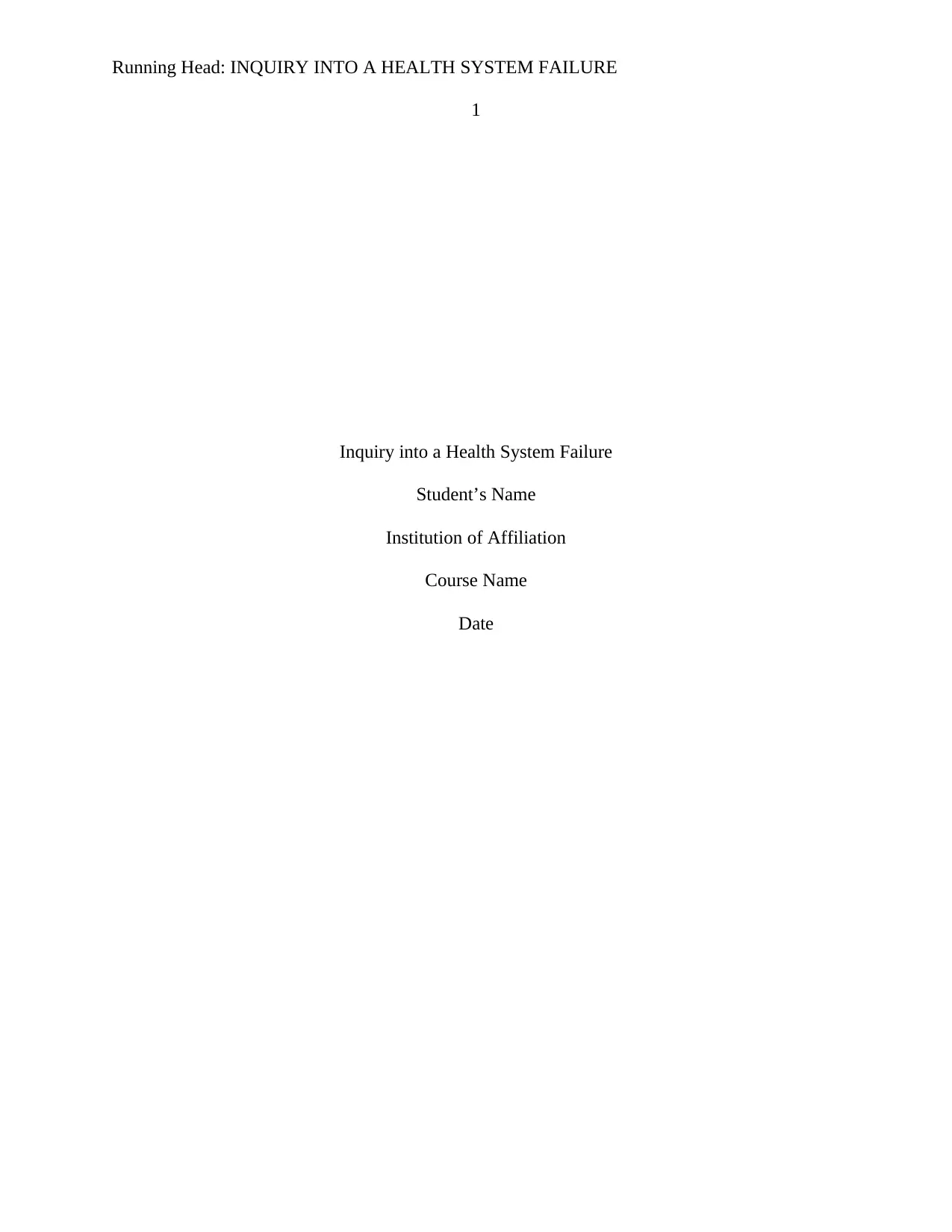
Running Head: INQUIRY INTO A HEALTH SYSTEM FAILURE
1
Inquiry into a Health System Failure
Student’s Name
Institution of Affiliation
Course Name
Date
1
Inquiry into a Health System Failure
Student’s Name
Institution of Affiliation
Course Name
Date
Secure Best Marks with AI Grader
Need help grading? Try our AI Grader for instant feedback on your assignments.
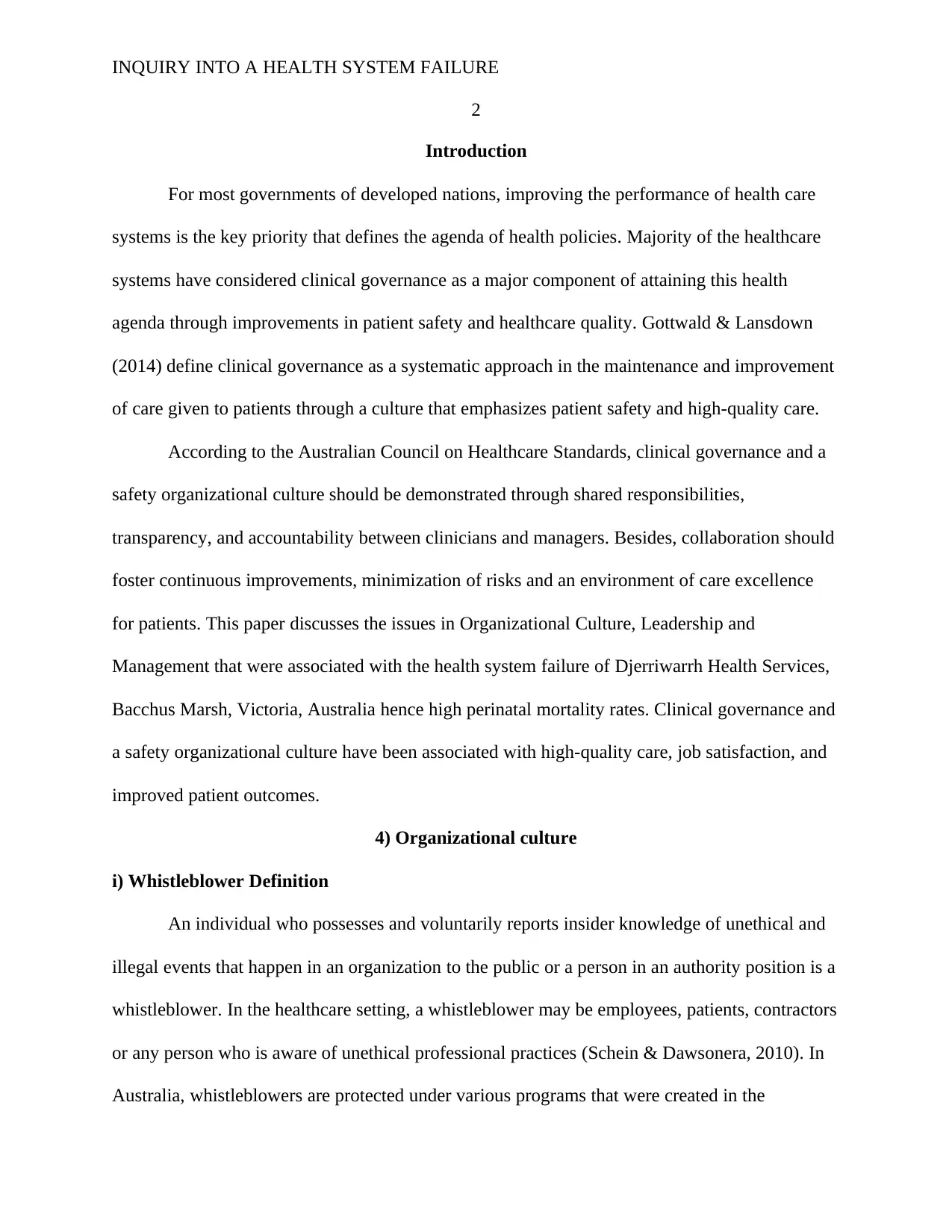
INQUIRY INTO A HEALTH SYSTEM FAILURE
2
Introduction
For most governments of developed nations, improving the performance of health care
systems is the key priority that defines the agenda of health policies. Majority of the healthcare
systems have considered clinical governance as a major component of attaining this health
agenda through improvements in patient safety and healthcare quality. Gottwald & Lansdown
(2014) define clinical governance as a systematic approach in the maintenance and improvement
of care given to patients through a culture that emphasizes patient safety and high-quality care.
According to the Australian Council on Healthcare Standards, clinical governance and a
safety organizational culture should be demonstrated through shared responsibilities,
transparency, and accountability between clinicians and managers. Besides, collaboration should
foster continuous improvements, minimization of risks and an environment of care excellence
for patients. This paper discusses the issues in Organizational Culture, Leadership and
Management that were associated with the health system failure of Djerriwarrh Health Services,
Bacchus Marsh, Victoria, Australia hence high perinatal mortality rates. Clinical governance and
a safety organizational culture have been associated with high-quality care, job satisfaction, and
improved patient outcomes.
4) Organizational culture
i) Whistleblower Definition
An individual who possesses and voluntarily reports insider knowledge of unethical and
illegal events that happen in an organization to the public or a person in an authority position is a
whistleblower. In the healthcare setting, a whistleblower may be employees, patients, contractors
or any person who is aware of unethical professional practices (Schein & Dawsonera, 2010). In
Australia, whistleblowers are protected under various programs that were created in the
2
Introduction
For most governments of developed nations, improving the performance of health care
systems is the key priority that defines the agenda of health policies. Majority of the healthcare
systems have considered clinical governance as a major component of attaining this health
agenda through improvements in patient safety and healthcare quality. Gottwald & Lansdown
(2014) define clinical governance as a systematic approach in the maintenance and improvement
of care given to patients through a culture that emphasizes patient safety and high-quality care.
According to the Australian Council on Healthcare Standards, clinical governance and a
safety organizational culture should be demonstrated through shared responsibilities,
transparency, and accountability between clinicians and managers. Besides, collaboration should
foster continuous improvements, minimization of risks and an environment of care excellence
for patients. This paper discusses the issues in Organizational Culture, Leadership and
Management that were associated with the health system failure of Djerriwarrh Health Services,
Bacchus Marsh, Victoria, Australia hence high perinatal mortality rates. Clinical governance and
a safety organizational culture have been associated with high-quality care, job satisfaction, and
improved patient outcomes.
4) Organizational culture
i) Whistleblower Definition
An individual who possesses and voluntarily reports insider knowledge of unethical and
illegal events that happen in an organization to the public or a person in an authority position is a
whistleblower. In the healthcare setting, a whistleblower may be employees, patients, contractors
or any person who is aware of unethical professional practices (Schein & Dawsonera, 2010). In
Australia, whistleblowers are protected under various programs that were created in the
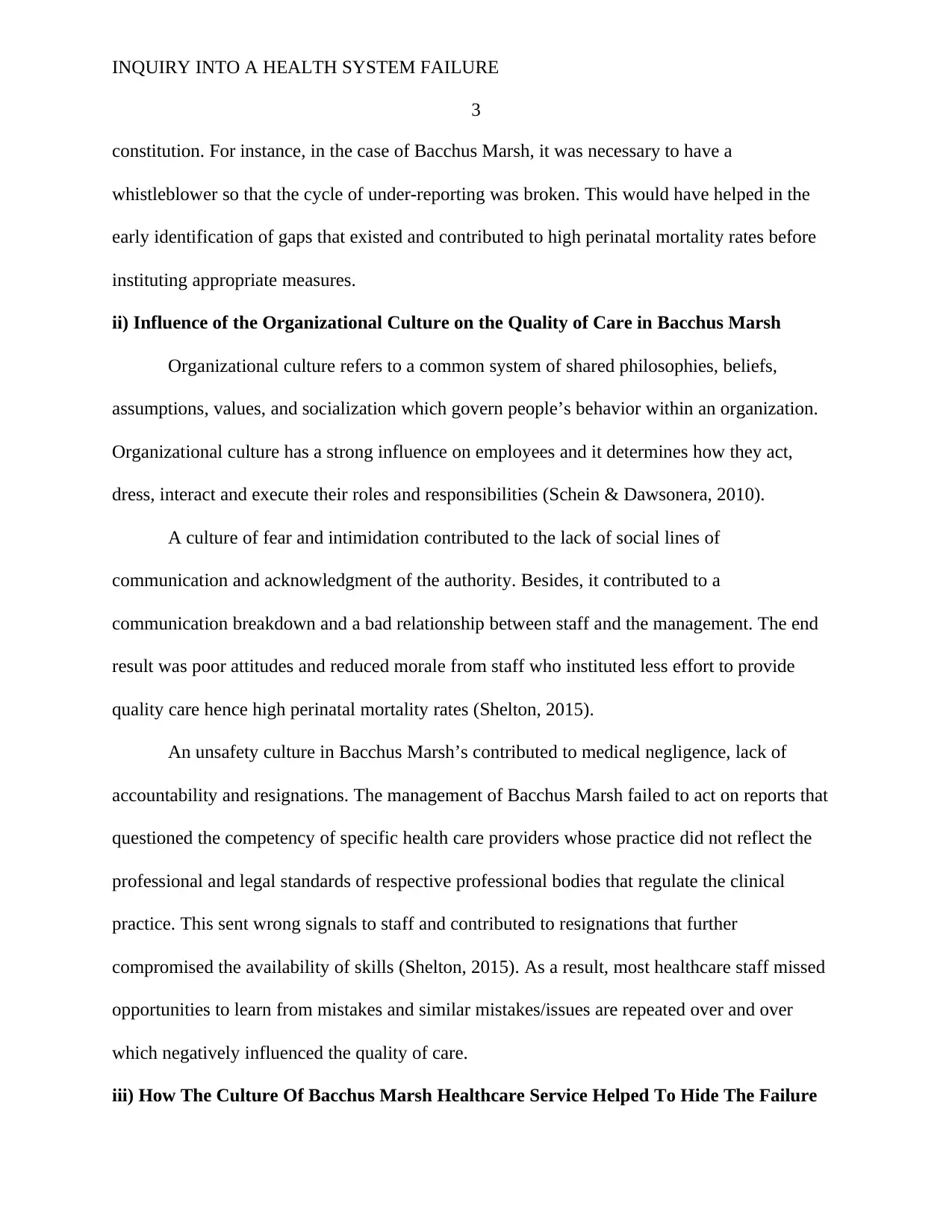
INQUIRY INTO A HEALTH SYSTEM FAILURE
3
constitution. For instance, in the case of Bacchus Marsh, it was necessary to have a
whistleblower so that the cycle of under-reporting was broken. This would have helped in the
early identification of gaps that existed and contributed to high perinatal mortality rates before
instituting appropriate measures.
ii) Influence of the Organizational Culture on the Quality of Care in Bacchus Marsh
Organizational culture refers to a common system of shared philosophies, beliefs,
assumptions, values, and socialization which govern people’s behavior within an organization.
Organizational culture has a strong influence on employees and it determines how they act,
dress, interact and execute their roles and responsibilities (Schein & Dawsonera, 2010).
A culture of fear and intimidation contributed to the lack of social lines of
communication and acknowledgment of the authority. Besides, it contributed to a
communication breakdown and a bad relationship between staff and the management. The end
result was poor attitudes and reduced morale from staff who instituted less effort to provide
quality care hence high perinatal mortality rates (Shelton, 2015).
An unsafety culture in Bacchus Marsh’s contributed to medical negligence, lack of
accountability and resignations. The management of Bacchus Marsh failed to act on reports that
questioned the competency of specific health care providers whose practice did not reflect the
professional and legal standards of respective professional bodies that regulate the clinical
practice. This sent wrong signals to staff and contributed to resignations that further
compromised the availability of skills (Shelton, 2015). As a result, most healthcare staff missed
opportunities to learn from mistakes and similar mistakes/issues are repeated over and over
which negatively influenced the quality of care.
iii) How The Culture Of Bacchus Marsh Healthcare Service Helped To Hide The Failure
3
constitution. For instance, in the case of Bacchus Marsh, it was necessary to have a
whistleblower so that the cycle of under-reporting was broken. This would have helped in the
early identification of gaps that existed and contributed to high perinatal mortality rates before
instituting appropriate measures.
ii) Influence of the Organizational Culture on the Quality of Care in Bacchus Marsh
Organizational culture refers to a common system of shared philosophies, beliefs,
assumptions, values, and socialization which govern people’s behavior within an organization.
Organizational culture has a strong influence on employees and it determines how they act,
dress, interact and execute their roles and responsibilities (Schein & Dawsonera, 2010).
A culture of fear and intimidation contributed to the lack of social lines of
communication and acknowledgment of the authority. Besides, it contributed to a
communication breakdown and a bad relationship between staff and the management. The end
result was poor attitudes and reduced morale from staff who instituted less effort to provide
quality care hence high perinatal mortality rates (Shelton, 2015).
An unsafety culture in Bacchus Marsh’s contributed to medical negligence, lack of
accountability and resignations. The management of Bacchus Marsh failed to act on reports that
questioned the competency of specific health care providers whose practice did not reflect the
professional and legal standards of respective professional bodies that regulate the clinical
practice. This sent wrong signals to staff and contributed to resignations that further
compromised the availability of skills (Shelton, 2015). As a result, most healthcare staff missed
opportunities to learn from mistakes and similar mistakes/issues are repeated over and over
which negatively influenced the quality of care.
iii) How The Culture Of Bacchus Marsh Healthcare Service Helped To Hide The Failure

INQUIRY INTO A HEALTH SYSTEM FAILURE
4
Bacchus Marsh did not have a transparent reporting culture where issues raised were
openly addressed and feedback provided to patients or concerned health care providers. Instead,
staff was punished, intimidated or warned (Spooner, 2017). Failure to provide feedback to
complains raised by staff contributed to their reluctance to make further reports and this limited
the improvement efforts of the organization. Besides, a closed loop communication system
limited the information that the management obtained through healthcare staff and contributed to
a culture of fear and intimidation (Spooner, 2017). This resulted in a bad relationship between
healthcare providers and the management and contributed to victimization and blaming and
hence hide the failure.
Bacchus Marsh had a culture that failed to monitor performance and hold healthcare
providers accountable for their mistakes. For instance, the reports on bullying and sexual
harassment of junior surgeons by superiors are a perfect example that revealed how senior
healthcare practitioners were unquestionable and this helps to question on some of the
competencies that staff had (Olson, 2015). The failure by the management to take action on
harassments and hold staff responsible for their mistakes through monitoring of performance
helped to hide the failure of the healthcare system.
Leadership and management
i) Characteristics of An Open and Transparent Leader
Approachable
An open and transparent leader is approachable. He/she does not cultivate fear and
intimidation amongst team members. Instead, he/she encourages team members to be free and
openly share about individual and group struggles, challenges and disagreements (Chambers,
2013). He/she helps team members to understand that disappoint fears and inadequacy are
4
Bacchus Marsh did not have a transparent reporting culture where issues raised were
openly addressed and feedback provided to patients or concerned health care providers. Instead,
staff was punished, intimidated or warned (Spooner, 2017). Failure to provide feedback to
complains raised by staff contributed to their reluctance to make further reports and this limited
the improvement efforts of the organization. Besides, a closed loop communication system
limited the information that the management obtained through healthcare staff and contributed to
a culture of fear and intimidation (Spooner, 2017). This resulted in a bad relationship between
healthcare providers and the management and contributed to victimization and blaming and
hence hide the failure.
Bacchus Marsh had a culture that failed to monitor performance and hold healthcare
providers accountable for their mistakes. For instance, the reports on bullying and sexual
harassment of junior surgeons by superiors are a perfect example that revealed how senior
healthcare practitioners were unquestionable and this helps to question on some of the
competencies that staff had (Olson, 2015). The failure by the management to take action on
harassments and hold staff responsible for their mistakes through monitoring of performance
helped to hide the failure of the healthcare system.
Leadership and management
i) Characteristics of An Open and Transparent Leader
Approachable
An open and transparent leader is approachable. He/she does not cultivate fear and
intimidation amongst team members. Instead, he/she encourages team members to be free and
openly share about individual and group struggles, challenges and disagreements (Chambers,
2013). He/she helps team members to understand that disappoint fears and inadequacy are
Secure Best Marks with AI Grader
Need help grading? Try our AI Grader for instant feedback on your assignments.
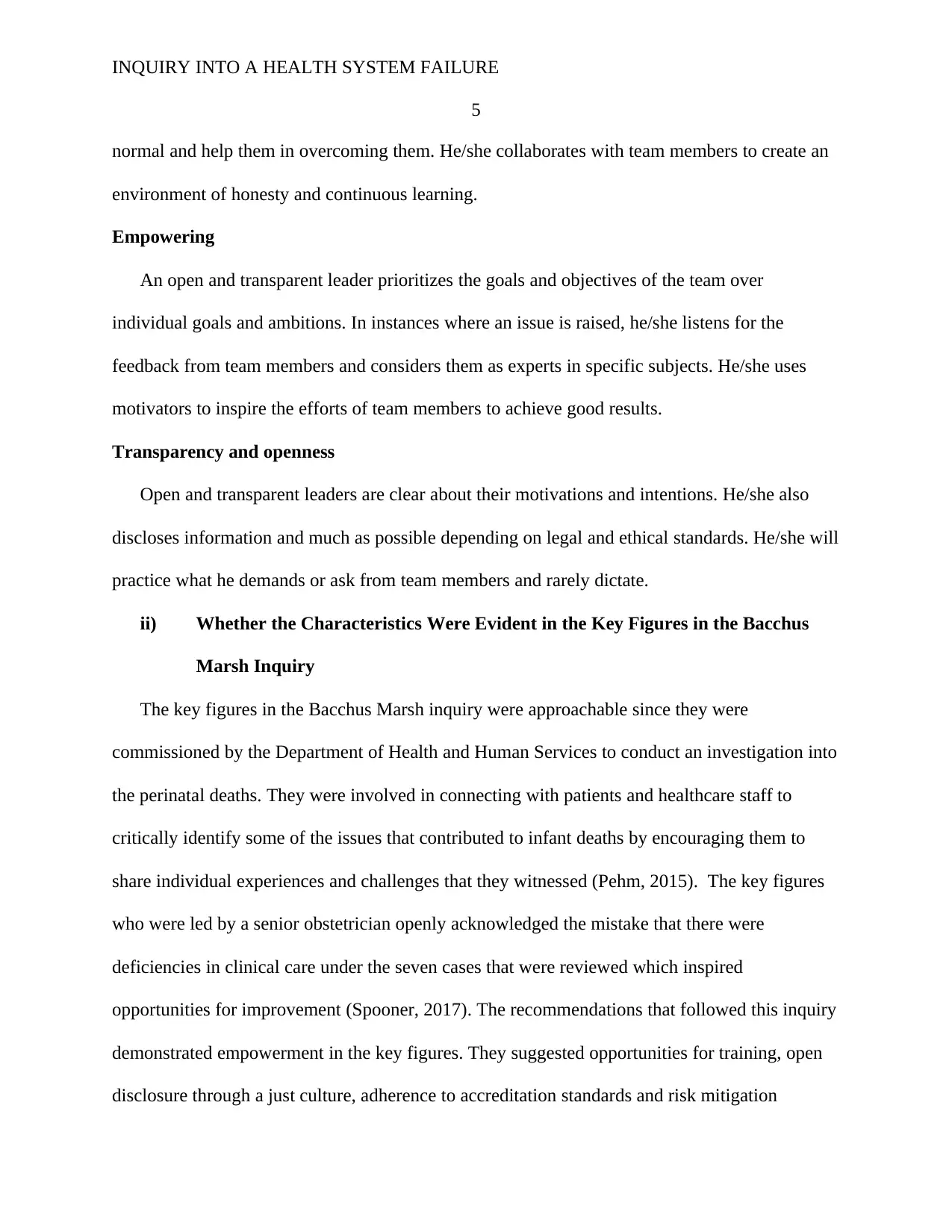
INQUIRY INTO A HEALTH SYSTEM FAILURE
5
normal and help them in overcoming them. He/she collaborates with team members to create an
environment of honesty and continuous learning.
Empowering
An open and transparent leader prioritizes the goals and objectives of the team over
individual goals and ambitions. In instances where an issue is raised, he/she listens for the
feedback from team members and considers them as experts in specific subjects. He/she uses
motivators to inspire the efforts of team members to achieve good results.
Transparency and openness
Open and transparent leaders are clear about their motivations and intentions. He/she also
discloses information and much as possible depending on legal and ethical standards. He/she will
practice what he demands or ask from team members and rarely dictate.
ii) Whether the Characteristics Were Evident in the Key Figures in the Bacchus
Marsh Inquiry
The key figures in the Bacchus Marsh inquiry were approachable since they were
commissioned by the Department of Health and Human Services to conduct an investigation into
the perinatal deaths. They were involved in connecting with patients and healthcare staff to
critically identify some of the issues that contributed to infant deaths by encouraging them to
share individual experiences and challenges that they witnessed (Pehm, 2015). The key figures
who were led by a senior obstetrician openly acknowledged the mistake that there were
deficiencies in clinical care under the seven cases that were reviewed which inspired
opportunities for improvement (Spooner, 2017). The recommendations that followed this inquiry
demonstrated empowerment in the key figures. They suggested opportunities for training, open
disclosure through a just culture, adherence to accreditation standards and risk mitigation
5
normal and help them in overcoming them. He/she collaborates with team members to create an
environment of honesty and continuous learning.
Empowering
An open and transparent leader prioritizes the goals and objectives of the team over
individual goals and ambitions. In instances where an issue is raised, he/she listens for the
feedback from team members and considers them as experts in specific subjects. He/she uses
motivators to inspire the efforts of team members to achieve good results.
Transparency and openness
Open and transparent leaders are clear about their motivations and intentions. He/she also
discloses information and much as possible depending on legal and ethical standards. He/she will
practice what he demands or ask from team members and rarely dictate.
ii) Whether the Characteristics Were Evident in the Key Figures in the Bacchus
Marsh Inquiry
The key figures in the Bacchus Marsh inquiry were approachable since they were
commissioned by the Department of Health and Human Services to conduct an investigation into
the perinatal deaths. They were involved in connecting with patients and healthcare staff to
critically identify some of the issues that contributed to infant deaths by encouraging them to
share individual experiences and challenges that they witnessed (Pehm, 2015). The key figures
who were led by a senior obstetrician openly acknowledged the mistake that there were
deficiencies in clinical care under the seven cases that were reviewed which inspired
opportunities for improvement (Spooner, 2017). The recommendations that followed this inquiry
demonstrated empowerment in the key figures. They suggested opportunities for training, open
disclosure through a just culture, adherence to accreditation standards and risk mitigation
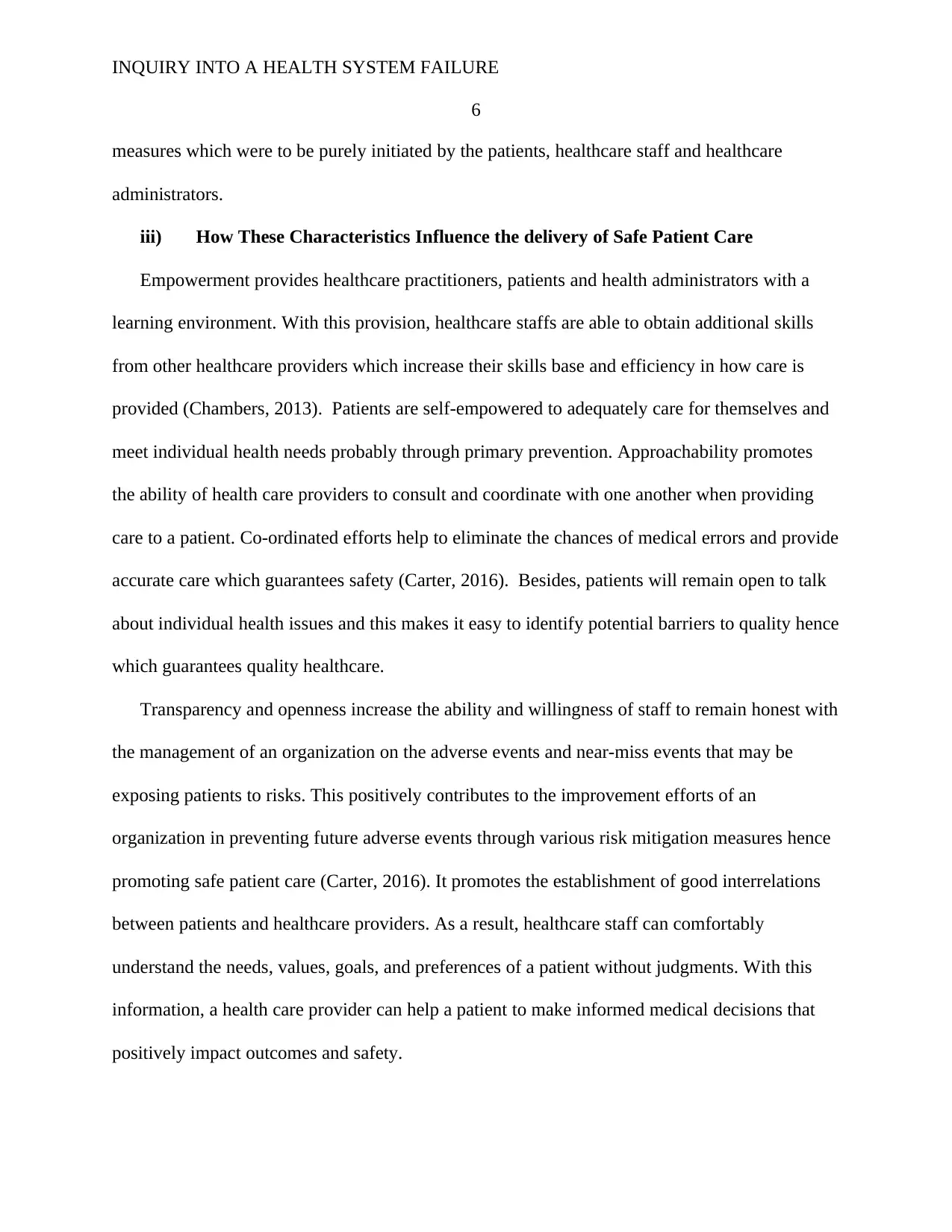
INQUIRY INTO A HEALTH SYSTEM FAILURE
6
measures which were to be purely initiated by the patients, healthcare staff and healthcare
administrators.
iii) How These Characteristics Influence the delivery of Safe Patient Care
Empowerment provides healthcare practitioners, patients and health administrators with a
learning environment. With this provision, healthcare staffs are able to obtain additional skills
from other healthcare providers which increase their skills base and efficiency in how care is
provided (Chambers, 2013). Patients are self-empowered to adequately care for themselves and
meet individual health needs probably through primary prevention. Approachability promotes
the ability of health care providers to consult and coordinate with one another when providing
care to a patient. Co-ordinated efforts help to eliminate the chances of medical errors and provide
accurate care which guarantees safety (Carter, 2016). Besides, patients will remain open to talk
about individual health issues and this makes it easy to identify potential barriers to quality hence
which guarantees quality healthcare.
Transparency and openness increase the ability and willingness of staff to remain honest with
the management of an organization on the adverse events and near-miss events that may be
exposing patients to risks. This positively contributes to the improvement efforts of an
organization in preventing future adverse events through various risk mitigation measures hence
promoting safe patient care (Carter, 2016). It promotes the establishment of good interrelations
between patients and healthcare providers. As a result, healthcare staff can comfortably
understand the needs, values, goals, and preferences of a patient without judgments. With this
information, a health care provider can help a patient to make informed medical decisions that
positively impact outcomes and safety.
6
measures which were to be purely initiated by the patients, healthcare staff and healthcare
administrators.
iii) How These Characteristics Influence the delivery of Safe Patient Care
Empowerment provides healthcare practitioners, patients and health administrators with a
learning environment. With this provision, healthcare staffs are able to obtain additional skills
from other healthcare providers which increase their skills base and efficiency in how care is
provided (Chambers, 2013). Patients are self-empowered to adequately care for themselves and
meet individual health needs probably through primary prevention. Approachability promotes
the ability of health care providers to consult and coordinate with one another when providing
care to a patient. Co-ordinated efforts help to eliminate the chances of medical errors and provide
accurate care which guarantees safety (Carter, 2016). Besides, patients will remain open to talk
about individual health issues and this makes it easy to identify potential barriers to quality hence
which guarantees quality healthcare.
Transparency and openness increase the ability and willingness of staff to remain honest with
the management of an organization on the adverse events and near-miss events that may be
exposing patients to risks. This positively contributes to the improvement efforts of an
organization in preventing future adverse events through various risk mitigation measures hence
promoting safe patient care (Carter, 2016). It promotes the establishment of good interrelations
between patients and healthcare providers. As a result, healthcare staff can comfortably
understand the needs, values, goals, and preferences of a patient without judgments. With this
information, a health care provider can help a patient to make informed medical decisions that
positively impact outcomes and safety.
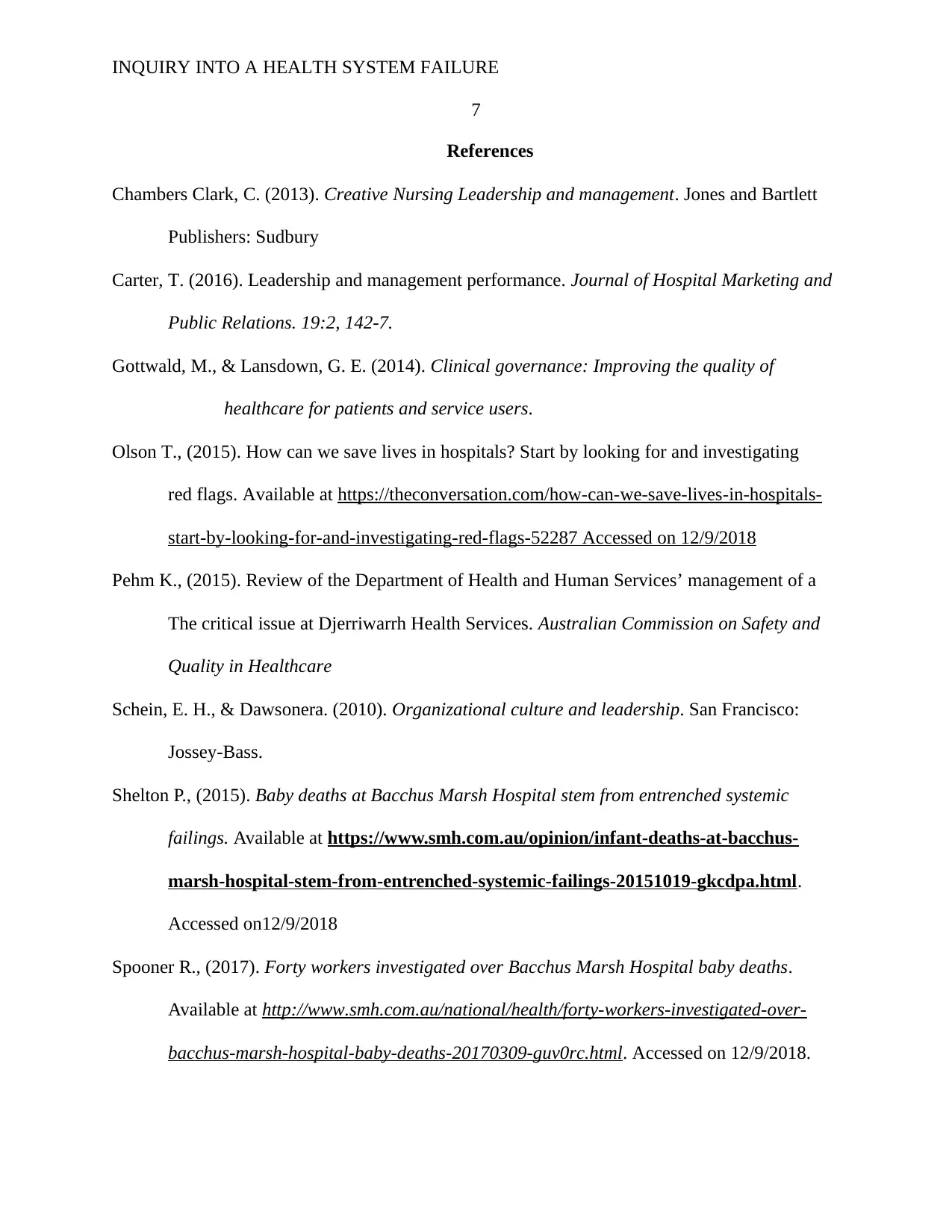
INQUIRY INTO A HEALTH SYSTEM FAILURE
7
References
Chambers Clark, C. (2013). Creative Nursing Leadership and management. Jones and Bartlett
Publishers: Sudbury
Carter, T. (2016). Leadership and management performance. Journal of Hospital Marketing and
Public Relations. 19:2, 142-7.
Gottwald, M., & Lansdown, G. E. (2014). Clinical governance: Improving the quality of
healthcare for patients and service users.
Olson T., (2015). How can we save lives in hospitals? Start by looking for and investigating
red flags. Available at https://theconversation.com/how-can-we-save-lives-in-hospitals-
start-by-looking-for-and-investigating-red-flags-52287 Accessed on 12/9/2018
Pehm K., (2015). Review of the Department of Health and Human Services’ management of a
The critical issue at Djerriwarrh Health Services. Australian Commission on Safety and
Quality in Healthcare
Schein, E. H., & Dawsonera. (2010). Organizational culture and leadership. San Francisco:
Jossey-Bass.
Shelton P., (2015). Baby deaths at Bacchus Marsh Hospital stem from entrenched systemic
failings. Available at https://www.smh.com.au/opinion/infant-deaths-at-bacchus-
marsh-hospital-stem-from-entrenched-systemic-failings-20151019-gkcdpa.html.
Accessed on12/9/2018
Spooner R., (2017). Forty workers investigated over Bacchus Marsh Hospital baby deaths.
Available at http://www.smh.com.au/national/health/forty-workers-investigated-over-
bacchus-marsh-hospital-baby-deaths-20170309-guv0rc.html. Accessed on 12/9/2018.
7
References
Chambers Clark, C. (2013). Creative Nursing Leadership and management. Jones and Bartlett
Publishers: Sudbury
Carter, T. (2016). Leadership and management performance. Journal of Hospital Marketing and
Public Relations. 19:2, 142-7.
Gottwald, M., & Lansdown, G. E. (2014). Clinical governance: Improving the quality of
healthcare for patients and service users.
Olson T., (2015). How can we save lives in hospitals? Start by looking for and investigating
red flags. Available at https://theconversation.com/how-can-we-save-lives-in-hospitals-
start-by-looking-for-and-investigating-red-flags-52287 Accessed on 12/9/2018
Pehm K., (2015). Review of the Department of Health and Human Services’ management of a
The critical issue at Djerriwarrh Health Services. Australian Commission on Safety and
Quality in Healthcare
Schein, E. H., & Dawsonera. (2010). Organizational culture and leadership. San Francisco:
Jossey-Bass.
Shelton P., (2015). Baby deaths at Bacchus Marsh Hospital stem from entrenched systemic
failings. Available at https://www.smh.com.au/opinion/infant-deaths-at-bacchus-
marsh-hospital-stem-from-entrenched-systemic-failings-20151019-gkcdpa.html.
Accessed on12/9/2018
Spooner R., (2017). Forty workers investigated over Bacchus Marsh Hospital baby deaths.
Available at http://www.smh.com.au/national/health/forty-workers-investigated-over-
bacchus-marsh-hospital-baby-deaths-20170309-guv0rc.html. Accessed on 12/9/2018.
Paraphrase This Document
Need a fresh take? Get an instant paraphrase of this document with our AI Paraphraser
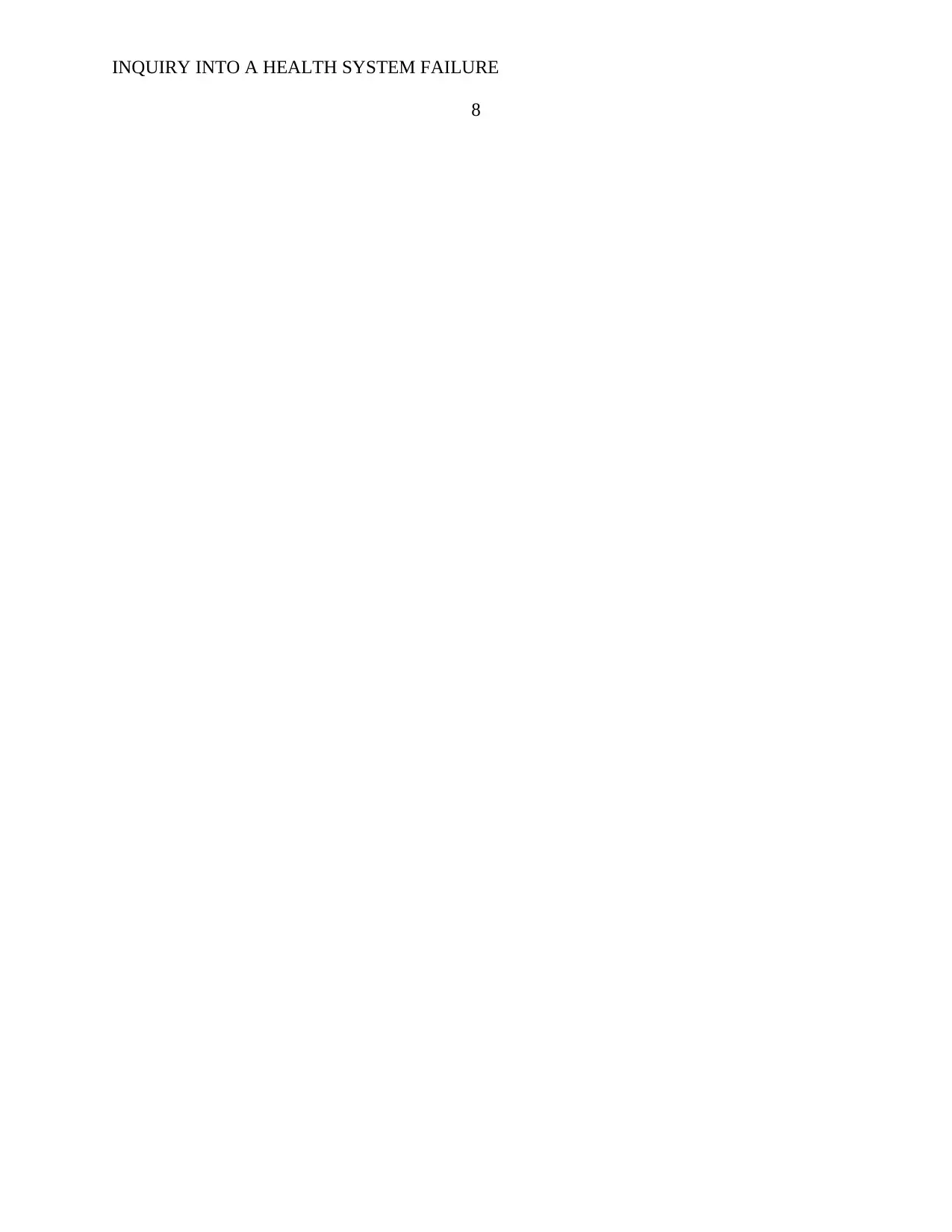
INQUIRY INTO A HEALTH SYSTEM FAILURE
8
8
1 out of 8
Related Documents
Your All-in-One AI-Powered Toolkit for Academic Success.
+13062052269
info@desklib.com
Available 24*7 on WhatsApp / Email
![[object Object]](/_next/static/media/star-bottom.7253800d.svg)
Unlock your academic potential
© 2024 | Zucol Services PVT LTD | All rights reserved.





